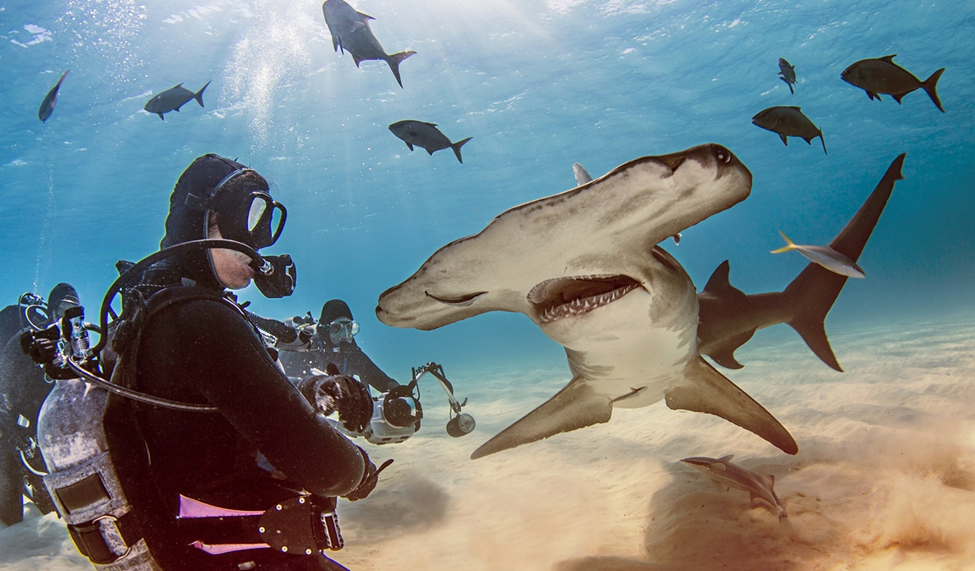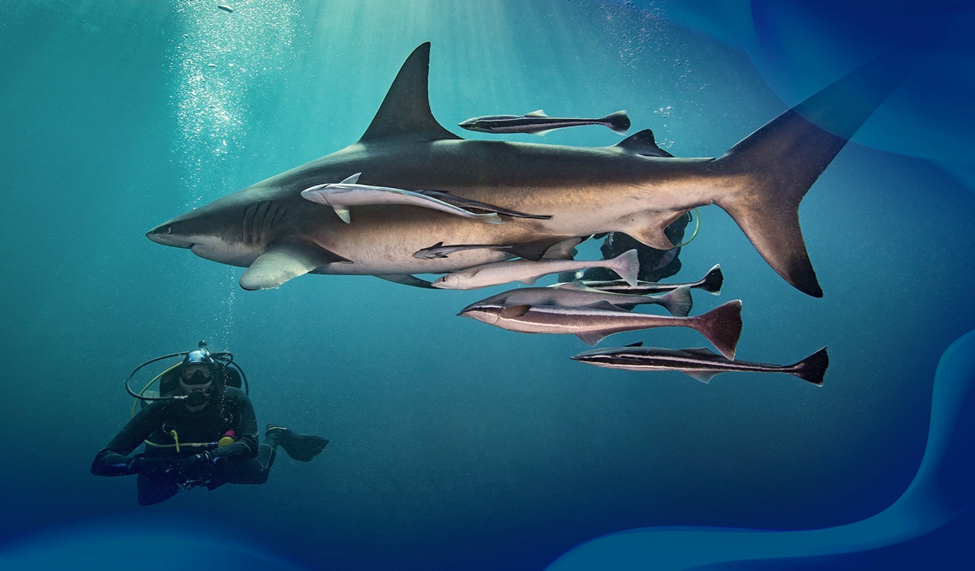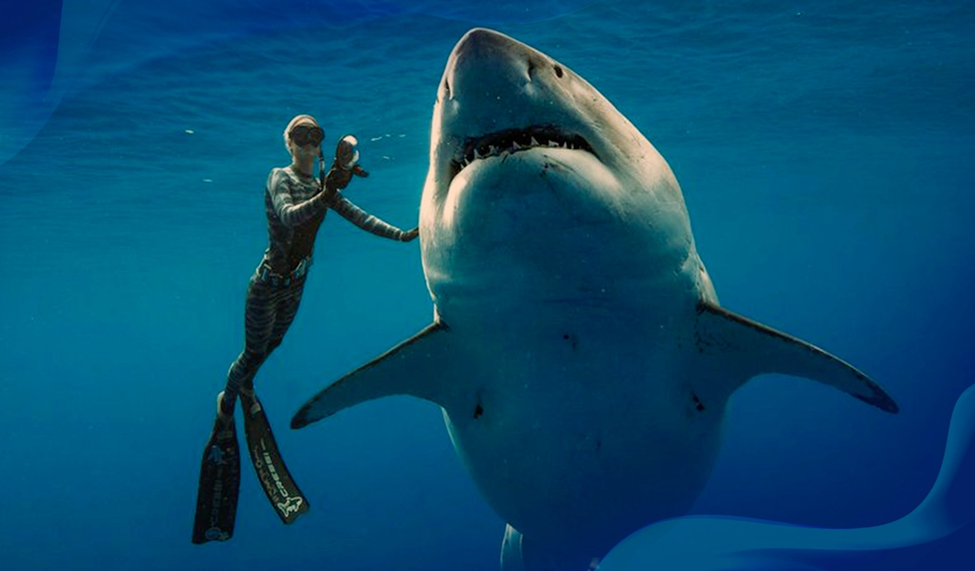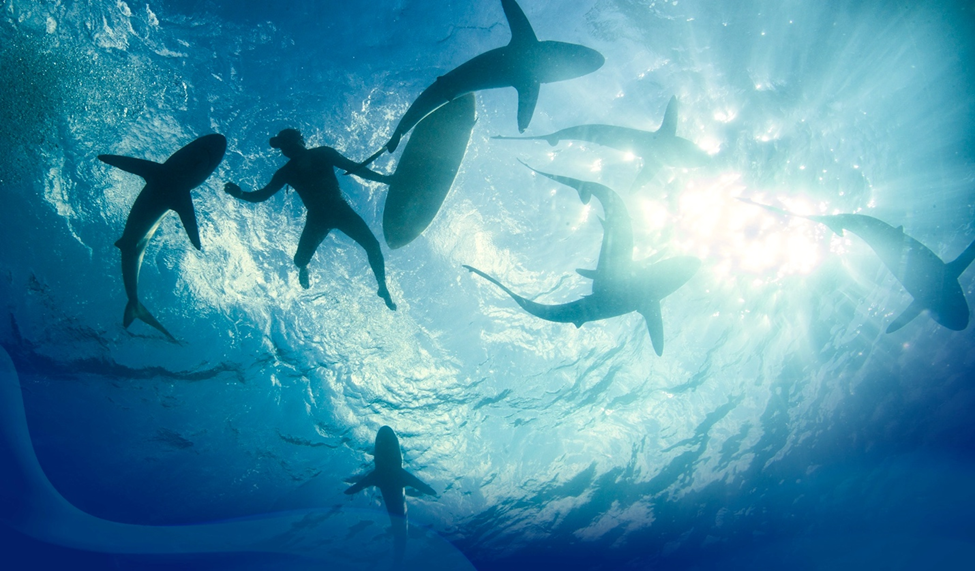
Shark diving. Simply hearing the phrase might make your blood run cold. Maybe it conjures up images of razor-sharp teeth or terrifying close calls.
But how much of that fear is grounded in reality? How much is nothing more than a myth?
These mighty creatures are fascinating – there’s a reason Shark Week has been around for over 35 years. But how much of that fascination is rooted in fear? The truth is that diving with sharks is far less dangerous than many believe. Here, we break down the exhilarating world of freediving with sharks, debunk common misconceptions, and explore why these oft-misunderstood creatures are so crucial to our oceans. We’ll also share key facts about different shark species, tips for safely diving with them (even for amateurs), and key techniques to ensure your next dive is both safe and unforgettable.
Ready to take the plunge and discover the true nature of these magnificent predators? You’ve come to the right place.
Shark Diving: Myth vs. Reality
To get started, let’s take a look at some of the most common misconceptions about shark diving (and the truths you need to know).
Myth #1: Shark Diving is Extremely Dangerous
From Jaws to Deep Blue Sea and everything in between, Hollywood movies have largely sensationalized the dangers of shark diving. These depictions have painted sharks as bloodthirsty monsters lurking in the shadows, eagerly awaiting their next bite.
The reality: Shark diving is actually relatively safe, particularly when done under the supervision of seasoned experts. Now, are there risks associated with shark diving? Absolutely. They’re still wild creatures in their natural habitat; as such, they need to be treated with respect. But when you follow the right safety protocols, you’ll discover that sharks aren’t the mindless killing machines the media unfairly makes them out to be.

Myth #2: Sharks Are Attracted to Human Blood
Again, the idea that sharks are drawn to human blood is a myth that’s been largely perpetuated by the media. The idea of a shark sensing a drop of blood and zeroing in on it like a missile might make for thrilling cinema, but how true is this in the real world?
The reality: The answer is not true at all. Yes, sharks can tell the difference between the blood of a human and that of their typical prey (i.e. fish). But there’s no scientific evidence to suggest that sharks are more drawn to human blood (or that they’re drawn to it at all, for that matter).
According to marine conservationist Ocean Ramsey, sharks will ignore humans the vast majority of the time because they don’t smell appealing to them.
Speaking to The Team Ignition Show host Leticia Bufoni, Ocean said: “Generally…even if [a shark approaches] a human…[it will say,] Nah. Not worth it. Doesn’t smell like my prey item, [it] isn’t splashing and trashing around like an injured animal.”
Myth #3: The Ocean is Packed with Sharks
It’s easy to imagine the ocean as a teeming mass of sharks, especially with the way they’re often portrayed in media. But is the reality of shark populations as overwhelming as the myth suggests? Not quite.
The reality: In truth, sharks are relatively scarce compared to other marine species. This is due in large part to the fact that many shark species are currently facing threats due to overfishing, habitat loss, and other human activities. Such threats pose a huge concern because of the crucial role sharks play in marine ecosystems.
Sharks: The Secret Keepers of Ocean Harmony
So, what role do sharks play from an ecological standpoint? Well, think of the ocean as a grand, intricate clockwork machine. Every cog and wheel plays a vital role in keeping the system running smoothly.
Well, sharks are the masterful mechanics making sure that this delicate balance remains intact.
Sharks, often misunderstood and maligned, are actually the unsung heroes of our oceans. These apex predators are not just fearsome hunters but crucial guardians of marine harmony.
When sharks patrol the seas, they exert a top-down influence on the marine food web. They keep the populations of smaller creatures in check, which prevents these species from hogging vital resources like seagrasses and corals.
Sharks also contribute to the genetic health of prey species, as they tend to target weak and sick creatures. This natural selection process helps maintain the overall vitality and resilience of marine populations.
“The role of sharks in the ecosystem] makes a lot of sense. If one sick fish is allowed to stay within a school of fish, it’s going to spread that disease to other fish. So you need those predators around. It also drives evolution because then only the strongest and fittest are going to survive,” says Ocean.

Staying Safe: 3 Shark Diving Safety Tips for Beginners
Diving with sharks can be an awe-inspiring experience. But ensuring your safety? That’s the top priority.
To help you do just that, here are three tips to help you navigate your first shark dive safely and confidently:
1. Know Your Shark Species
From great whites to tigers to hammerheads, there are hundreds of species of sharks you could encounter in the sea — and not all are created equal when it comes to interactions with humans.
Certain species — like reef sharks, nurse sharks, and hammerhead sharks — are more docile in nature, making them a good option for first-time divers. Do your research and try to dip your toe in with gentler species.
2. Gear Up: Invest in Proper Equipment
If you’re hoping for a safe and enjoyable dive, having the right gear is a must.
Depending on the water temperature, you’ll need a wetsuit or drysuit. These garments provide both protection and insulation. Not to mention, they also help you avoid accidental scrapes and stings.
A well-fitting dive mask and fins are also crucial. The mask will ensure that you can see exactly where you’re going (and what’s around you), while the fins will help with maneuverability.
3. Learn and Follow Safety Protocols
We’ve said it before, and we’ll say it again: when it comes to shark diving, safety is paramount. Be sure to get familiar with and abide by the relevant safety procedures at all times in the water.
Firstly, stay calm and still. Sudden movements can provoke curiosity or mistakes in identity. Avoid splashing to keep sharks from becoming agitated or mistaking you for prey.
Diving in a group is also a good safety measure as it can make you appear less vulnerable. Sharks are less likely to single you out if you’re surrounded by others.

Beneath the Surface: Unveiling The Truth about Shark Diving
As you gear up for your shark diving adventure, remember: these majestic creatures are key to maintaining the health of the ocean. By debunking common myths and following essential safety tips, you can experience the thrill of diving with sharks while respecting these incredible predators.
In the meantime, if you want to learn more about these exceptional animals, be sure to listen to Ocean Ramsey’s appearance on The Team Ignition Show. In the episode, Ocean shares her incredible shark encounters and her hopes for a world in which sharks and humans can peacefully co-exist.



